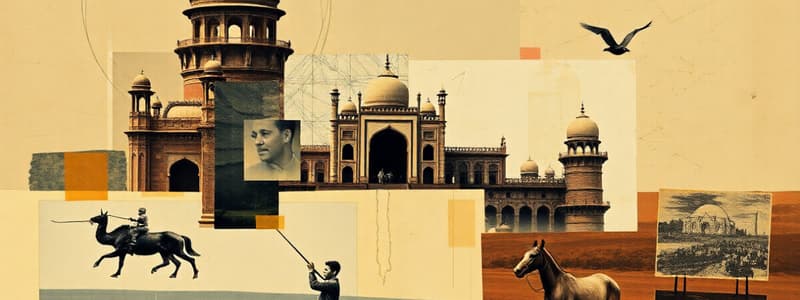Podcast
Questions and Answers
What percentage of poets mentioned in Sam Mirza's Tuhfa-’i Sami had migrated to India?
What percentage of poets mentioned in Sam Mirza's Tuhfa-’i Sami had migrated to India?
- 5 percent
- 1 percent (correct)
- 10 percent
- 15 percent
Which poet from Termez served Humayun as the royal huntsman before migrating?
Which poet from Termez served Humayun as the royal huntsman before migrating?
- Babur
- Jahangir
- Mawlana Shahid
- Amir Khanzada Hashim Daliri (correct)
Which tazkira, compiled in 1680, contains details of 903 poets?
Which tazkira, compiled in 1680, contains details of 903 poets?
- Tuhfa-’i Sami
- Dar al-Iqbal
- Tazkira-i Nasr-abadi (correct)
- Shahnameh
How many Indian origin poets resided in India, as mentioned in the Tazkira-i Nasr-abadi?
How many Indian origin poets resided in India, as mentioned in the Tazkira-i Nasr-abadi?
What was the major theme of the first chapter of Sam Mirza's Tuhfa-’i Sami?
What was the major theme of the first chapter of Sam Mirza's Tuhfa-’i Sami?
What does the term 'Persianate' refer to in the context of the migration of literati to Mughal India?
What does the term 'Persianate' refer to in the context of the migration of literati to Mughal India?
During which years did a significant number of Iranians serve as amirs in Mughal India?
During which years did a significant number of Iranians serve as amirs in Mughal India?
Which historical figure is NOT mentioned in the first tazkira?
Which historical figure is NOT mentioned in the first tazkira?
What factor significantly limited migration during the first half of the 16th century?
What factor significantly limited migration during the first half of the 16th century?
What is a tazkira in literary terms?
What is a tazkira in literary terms?
What distinguishes the Tazkira-i Nasr-abadi from Sam Mirza's work regarding Mughal India?
What distinguishes the Tazkira-i Nasr-abadi from Sam Mirza's work regarding Mughal India?
Which literary work is mentioned as a model for later tazkira literature?
Which literary work is mentioned as a model for later tazkira literature?
What percentage of Mughal amirs were from Central Asia during the period 1658-1678?
What percentage of Mughal amirs were from Central Asia during the period 1658-1678?
What aspect of migration does the paper highlight as challenging to comprehensively discuss?
What aspect of migration does the paper highlight as challenging to comprehensively discuss?
Which aspect of society did Persian poets and poets included in tazkiras represent?
Which aspect of society did Persian poets and poets included in tazkiras represent?
Which group had more representation in the Mughal court as amirs according to the data provided?
Which group had more representation in the Mughal court as amirs according to the data provided?
Who visited the emperor Aurangzeb after accompanying ‘Abd al-‘Aziz Khan on his pilgrimage?
Who visited the emperor Aurangzeb after accompanying ‘Abd al-‘Aziz Khan on his pilgrimage?
What position did ‘Abd Allah from Tashkent ultimately achieve in India?
What position did ‘Abd Allah from Tashkent ultimately achieve in India?
What was a significant aspect of the migration of Iranian and Central Asian literati to Mughal India?
What was a significant aspect of the migration of Iranian and Central Asian literati to Mughal India?
What was the primary reason that Central Asian migrants had limited success as poets in India?
What was the primary reason that Central Asian migrants had limited success as poets in India?
What was one of the barriers to the migration of literati among the states?
What was one of the barriers to the migration of literati among the states?
Which region did not experience significant migration of poets in the same manner as Iran and Central Asia?
Which region did not experience significant migration of poets in the same manner as Iran and Central Asia?
During Aurangzeb’s reign, what percentage of poets in India were Indian?
During Aurangzeb’s reign, what percentage of poets in India were Indian?
What did the Persianate culture brought by the migrants to India do?
What did the Persianate culture brought by the migrants to India do?
What percentage of poets listed in Mutribi Samarqandi's Tazkirat al-Shu’ara were from Central Asia?
What percentage of poets listed in Mutribi Samarqandi's Tazkirat al-Shu’ara were from Central Asia?
Which individual served the emperor Akbar after migrating from Central Asia?
Which individual served the emperor Akbar after migrating from Central Asia?
How many migrants from Central Asia were mentioned in Mutribi Samarqandi's first tazkira?
How many migrants from Central Asia were mentioned in Mutribi Samarqandi's first tazkira?
What was the primary reason for Kafshi Bukhara’i's migration to India?
What was the primary reason for Kafshi Bukhara’i's migration to India?
How many poets does Maliha's tazkira Muzakkir al-Ashab consist of?
How many poets does Maliha's tazkira Muzakkir al-Ashab consist of?
What profession did Kafshi Bukhara’i hold before migrating to India?
What profession did Kafshi Bukhara’i hold before migrating to India?
Which Central Asian poet was a prominent sui shaykh of the Kubraviyya Order?
Which Central Asian poet was a prominent sui shaykh of the Kubraviyya Order?
What percentage of poets in Maliha's tazkira were from Iran?
What percentage of poets in Maliha's tazkira were from Iran?
What is the main subject of the anthology discussed in the content?
What is the main subject of the anthology discussed in the content?
Which editor contributed to the work 'A World Connected by the Persian Language'?
Which editor contributed to the work 'A World Connected by the Persian Language'?
Which of the following works was mentioned as a source for the history of Central Asia?
Which of the following works was mentioned as a source for the history of Central Asia?
What specific cultural time frame do the works in the content mostly focus on?
What specific cultural time frame do the works in the content mostly focus on?
What issue is raised about the reliability of the mentioned book in the notes?
What issue is raised about the reliability of the mentioned book in the notes?
Which editor is associated with the work 'Tazkira-’i Nasr-abadi'?
Which editor is associated with the work 'Tazkira-’i Nasr-abadi'?
What does the work 'Glorious Past and an Outstanding Present' explore?
What does the work 'Glorious Past and an Outstanding Present' explore?
What is a common theme found in the studied works regarding Persian literature?
What is a common theme found in the studied works regarding Persian literature?
Flashcards are hidden until you start studying
Study Notes
Persianate Society in Mughal India
- The migration of Persian literati to Mughal India in the 16th and 17th centuries played a significant role in shaping the Persianate culture of the region.
- The term "Persianate" is used to describe cultural expressions inspired by the Persian language, encompassing a wider scope than just Persia itself.
- Mughal India was a prominent center for Persianate culture, attracting numerous Persian poets due to its generous patronage.
- The migration of Iranians and Central Asians enriched the literary landscape of Mughal India.
- The author utilizes "tazkiras" (anthologies of poetry with biographical sketches) to study the migration of Persianate literati to Mughal India.
- These tazkiras, prevalent across Persia, Central Asia, the Ottoman Empire, and Mughal India, provide insights into the movement of poets and other figures.
- The tazkiras reveal that Persian poetry was brought to Mughal India primarily by Iranian migrants.
- However, by the 17th century, Indian poets began to emerge, marking the process of Persianate culture taking root and flourishing in Mughal India.
Tazkira Analysis
- Safavid Iran's tazkiras primarily documented poets within the empire, but they also recorded migrations to India.
- Sam Mirza's Tuhfa-’i Sami, compiled in 1550, lists over 700 poets.
- The Tuhfa-’i Sami features only three Mughal emperors (Babur, Humayun, and ‘Askari Mirza) but lacks detailed information about Indian poets.
- Nasr-abadi's Tazkira-i Nasr-abadi (1680) contains more extensive information regarding Mughal India.
- It includes details on 27 literati, 12 of whom were Iranian migrants to India.
- It also mentions 17 poets of Indian origin residing in India.
- Mutribi Samarqandi's Tazkirat al-Shu’ara (1604) provides information about Central Asian poets who migrated to Mughal India.
- The tazkira highlights 21 migrants, comprising 9% of the Central Asian poets listed.
- While some migrants held academic and religious backgrounds, some were also merchants, artisans, and craftsmen.
- Maliha Samarqandi's Muzakkir al-Ashab (1692-3) highlights 20 Central Asian literati who visited or migrated to India.
- The tazkira notes that 10 of these individuals traveled to Mecca for pilgrimage and stopped in India on their return.
- This suggests the use of the Indian sea route for pilgrimages.
- It also documents individuals with ulama backgrounds who moved to Mughal India.
- While some Central Asian migrants became successful poets in India, Central Asia maintained scholarly and religious ties with Mughal India.
Boundaries of Migration
- The study identifies three boundaries that impacted the migration of literati.
- State Borders: While state borders existed between the Mughal, Safavid, and Uzbek states, these barriers did not prevent the movement of literati, demonstrating their ability to cross political boundaries for cultural and intellectual pursuits.
- Realm of Persianate Culture: Despite strong cultural connections between Iran, India, and Central Asia, the tazkiras only mention a few Ottoman poets, suggesting that the Ottoman Empire's Persianate culture did not significantly contribute to this migratory flow.
- Religious and Confessional Boundary: The study mentions that the shared Sunni Islam and Hanai school of law facilitated the migration of Central Asian scholars and ulama to Mughal India.
Studying That Suits You
Use AI to generate personalized quizzes and flashcards to suit your learning preferences.




